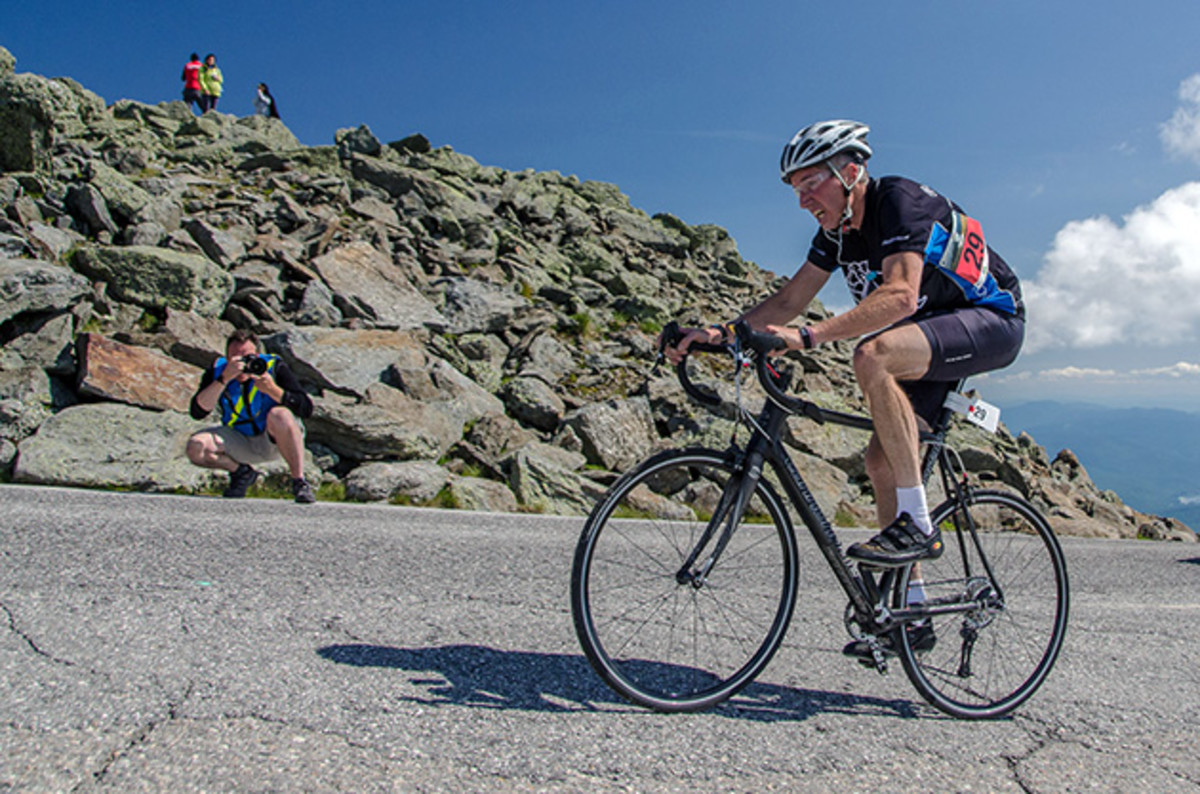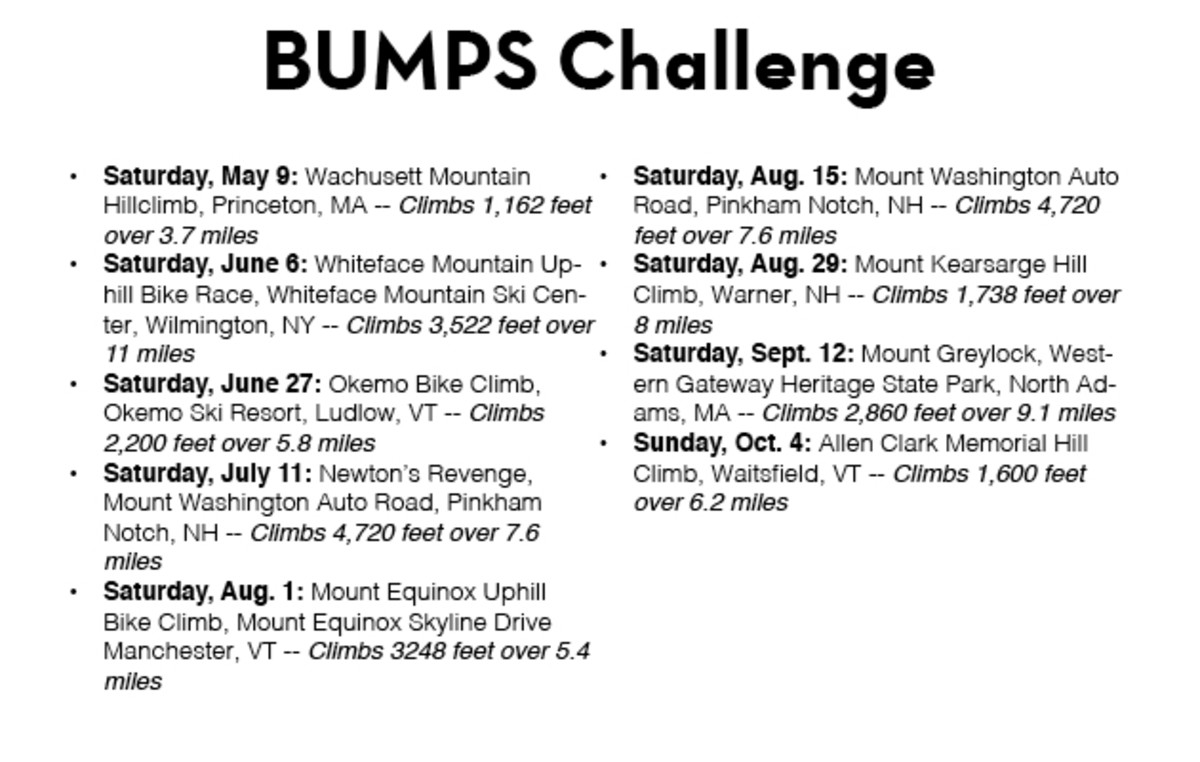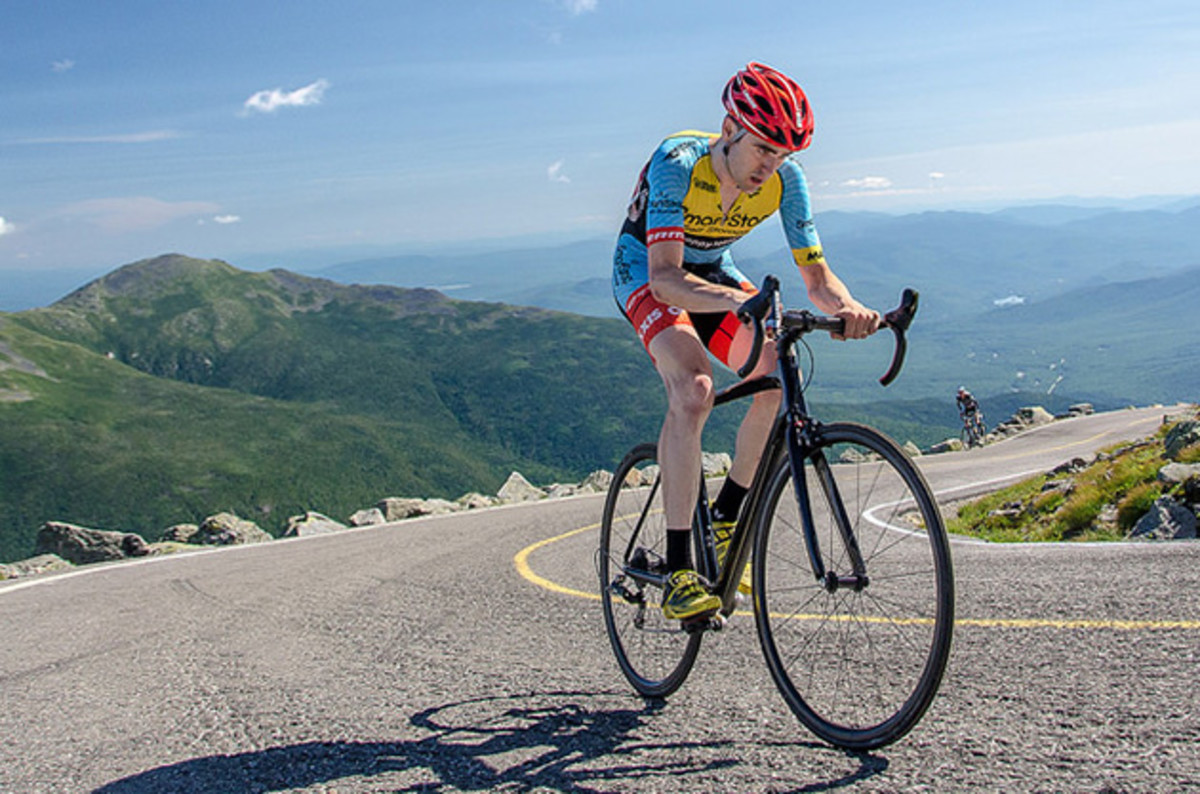In bike racing’s BUMPS challenge, it’s uphill all the way—and that's the thrill

With the exception of France’s legendary L’Alpe d’Huez, and perhaps Mont Ventoux, the haunting “Beast of Provence,” racing a bicycle uphill simply isn’t sexy. It rarely makes for great television, particularly when compared to the high-speed thrills, chills, and potential spills of racing downhill.
Pedaling uphill is not the domain of adrenaline junkies, those wild-haired riders who thrive on break-neck descents. Climbing isn’t fun. It’s work. Brutally honest work that couch potatoes can’t comprehend.
“There’s nothing like seeing the view from the top, looking down to where you started, and knowing it was just you, under your own power, that got you to the top,” says Joe Tonon, 50, a veteran cyclist from Marblehead, Mass.
In some strange, intriguing way, that purity of effort is exactly what makes uphill bike racing so enticing. Start at the bottom, finish at the summit. These oddly alluring competitions have proven so popular in the Northeast that they’ve spawned the Bike Up the Mountain Points Series, popularly known as the BUMPS Challenge.
“While riding uphill is difficult, and a challenge, so is life,” says Tonon, who owns Destination Cycling, the chief sponsor of the BUMPS Challenge. "I think many riders see this series as a way to keep their personal lives pointed in the right direction, with good nutrition, plenty of sleep to aid in recovery, and the constant need to set goals, attain them, and keep their life on track.”
Birth of Extreme Skiing: The thrill and terror at Tuckerman Ravine
Jay Curry, 43, of Newburyport, MA, agrees, saying that a day on the hill, defying gravity, can serve as a metaphor for day-to-day tribulations.
“You have to learn to dig deep, fight through the pain,” says Curry. “We all have bad times that come into our lives. They pass, just like they’ll pass during a race.”
Launched in 2009, the BUMPS Challenge combines nine of the Northeast’s top uphill bicycle races. Events are held in Vermont, New Hampshire, New York and Massachusetts (see sidebar). Some are time-trial formats, and others are mass starts. Competitors can take part in one race, or all nine. Anyone who enters a BUMPS event is automatically entered in the series, but racers must compete in five events to qualify for the overall titles of Queen and King of the Hill.
“The series has been amazingly popular with the over-50, over-60 and even 70-year-olds,” says Tonon. “It seems like everyone is trying, and succeeding, at staying younger, and staying more fit.”
While all the BUMPS Challenge events will test the legs and lungs of each competitor, two races stand apart. Both are held on the Northeast’s highest peak, 6,288-foot Mount Washington in New Hampshire, affectionately nicknamed the Rockpile. Newton’s Revenge in July, and the Mount Washington Auto Road Bicycle Hillclimb in August (the granddaddy of New England hillclimb events), and their corresponding practice rides, are the only four days all year that this winding, relentless road is open to cyclists.

The other seven races range in elevation gain from 1,162 feet over 3.7 miles (Wachusett Mountain in Massachusetts) to 3,522 feet over 11 miles (Whiteface Mountain in New York). The Mount Washington Auto Road, rising 4,720 feet in just 7.6 miles, is an unmitigated monster.
“It just hurts on Mount Washington, even in good weather,” says Russ Holden, 43, of Boxborough, Mass. “Being willing to deal with the level of discomfort and pain, and not dial it back to be slightly more comfortable, is the challenge.”
Depending on whom you ask, these events are either a race or a ride. Sometimes, they’re a peculiar combination of both.
“I do road race, but hillclimbs are not races for me, really,” says Holden. “They’re time trials against my times from previous years, or against my goals for that year. They definitely aren’t rides. I would never ride Mt. Washington just to do it.”
Tonon understands.

“These are races, don’t let anyone fool you,” he says. “Anyone coming out for one of the BUMPS races has an inner competitive streak, a goal, a target. Sometimes it is against another rider, and sometimes it is all personal.”
Tonon only has to look across the kitchen table to find someone who fits that description perfectly. His wife, Marti Shea, is a former competitive runner who was once a Nike-sponsored athlete. At 29, she walked away from racing. When the competitive itch returned, at 43, she got on a bike.
The problem is that bike racing, especially on asphalt, can be a perilous pursuit. So Shea turned to hillclimb racing.
“No one wants to get hurt,” said Shea, now 52. “Simply put, hillclimbs are safe events.”
That’s another draw. While the steep incline means there’s no coasting, it also means that falls are relatively benign (even though the winds above treeline at Mount Washington have been known to knock riders over).

“I'm actually not a great descender, and especially don’t enjoy steep, fast descents,” says 52-year-old Anthony (Sandy) Codding, from Boston’s North Shore. “I have a strong competitive streak, so I do like to race. But I'm not as risk-tolerant as I once was. I like the slower, more controlled pace and feel of climbing races rather than criteriums or fast road races.”
Likewise, Shea says uphill events satisfy both the need to feel secure, and a craving for competition. Since she began racing uphill in 2006, Shea has won more than 35 hillclimbs, including seven Newton’s Revenge titles and four Mount Washington Auto Road crowns. But she still has plenty of competition within the uphill community.
“When I enter a hillclimb, it’s very much a race,” says 34-year-old Ana Sirianni, a Boston-area cyclist. “I expect to put out efforts that I haven’t seen previously in training.”
Age categories allow participants to compete against similar racers. There are even weight categories—heavyweights are known as Clydesdales—in some events.
“The BUMPS series is unique,” says Shea. “There is no other series in the world that has this many hillclimbs with the level of difficulty in such a convenient geographic location.”
Other participants, however, care less about winning, and more about personal achievement.
“Of course, there is the great sense of accomplishment when you reach the top,” said Codding.
That, according to practitioners of this particularly painful discipline of cycling, is the universal appeal. “It takes focus and discipline to maintain a steady pace in a hillclimb race,” says Daniel Ball, 51, of Westborough, Mass. "In every race, I see people who have pulled over to the side of the road or have gotten off of their bike and started walking because they started the race too fast and have burned themselves out.”
There are other rewards to hillclimb racing, but they’re more subtle, more sublime.
“I’ve heard a lot lately about the idea of finding certain moments in your life when you are in a ‘flow,’ or zone, and how the presence of these moments correlates with overall life happiness,” says Sirianni. “I guess climbing takes me to these places. I become totally and fully engrossed in the experience.
“Physically, I’m able to settle into a place where I am working extremely hard, but able to sustain my efforts,” she says. “The key for me is finding that edge.”
For details on the BUMPS Challenge, visit hillclimbseries.com.
